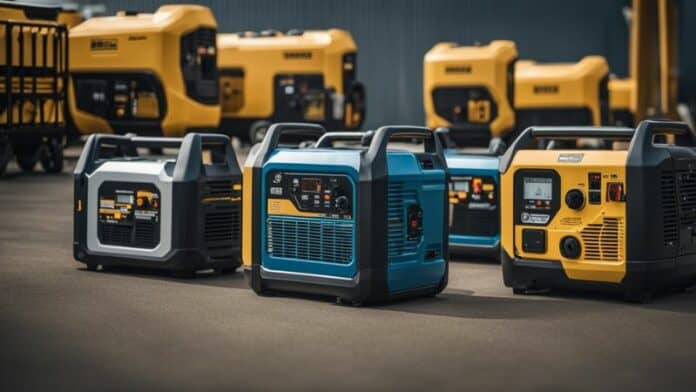Critical Role of Generators in Industry
Generators are absolutely essential in industry. They’re your reliable backup when the lights go out, keeping operations humming along in spite of outages.
It’s hard to overstate how much they matter for business continuity.
Ensuring Uninterrupted Power Supply
A steady power supply is non-negotiable for industrial work. Generators step in the moment the main power fails, so your processes don’t grind to a halt.
When the grid drops, your generator fires up—no need to panic or scramble. This is especially true for manufacturing, healthcare, and food services, where downtime just isn’t an option.
Think about it: a sudden outage could wreck a production line or fry sensitive equipment. With a generator, you can breathe a little easier and focus on keeping things moving.
Minimizing Downtime and Financial Loss
Power cuts aren’t just annoying—they can be seriously expensive. Generators help you dodge downtime and keep the money coming in.
If you lose production time, revenue takes a direct hit. Some industries even run into compliance headaches if power blips out.
Having a solid generator means you’re not leaving your business’s future up to chance. You keep projects on track and deadlines within reach.
Protecting Sensitive Industrial Equipment
Generators don’t just keep the lights on—they shield your gear, too. Voltage spikes and dips can fry machines and electronics, and repairs aren’t cheap.
With a generator providing stable juice, those risks drop way down. This is a big deal in places like hospitals, where life-support devices can’t afford a hiccup.
Investing in a quality generator now could save you a fortune in repairs and replacements later.
Types of Industrial Generators
There’s no one-size-fits-all generator. Industrial models come in different flavors, each with its perks and quirks. Picking the right one depends on what you need to power.
Diesel Generators in Industrial Usage
Diesel generators? They’re the old reliable of the bunch. People love them for their muscle and staying power—great for jobs that need a lot of juice, for a long time.
You’ll see diesel units on construction sites, in mines, even at hospitals. They run on diesel fuel, which is easy to find and reasonably priced.
Heavy loads? No problem. Diesel generators are built to take a beating and keep going, which is why they’re a favorite in rough-and-tumble industries.
Key Features:
-
High power output
-
Long operating times
-
Durable construction
Advantages of NG Generators
Natural gas (NG) generators are catching on, especially with the push for cleaner energy. They’re more eco-friendly and generally more efficient than diesel.
If you care about sustainability, NG generators are worth a close look. Lower emissions help meet environmental rules, and the fuel’s often cheaper in the long run.
They’re reliable for both backup and main power, so you get flexibility too.
Benefits of NG Generators:
-
Lower emissions
-
Cost-effective fuel
-
Reliable power output
Portable vs. Stationary Generators
Here’s something to mull over: do you need your generator to move, or stay put? Portable models are all about flexibility—you can haul them where you need them, so they’re perfect for temporary gigs.
Stationary generators, on the other hand, are built for the long haul. If you’re running a factory or data center, you’ll want one of these for serious, uninterrupted power.
Comparison:
|
Feature |
Portable Generators |
Stationary Generators |
|
Mobility |
High |
Low |
|
Power Output |
Usually lower |
Higher |
|
Use Case |
Temporary or emergency use |
Permanent installations |
Picking the right generator isn’t just a technical decision—it’s about what makes sense for your setup. What do you actually need to power, and how often?
Applications of Generators Across Industry Sectors
Generators are the unsung heroes across a bunch of industries. They step in when the grid lets you down, protecting your work and your investments.
Manufacturing Plants and Production Facilities
Manufacturing doesn’t forgive downtime. If the power dies, so does the production line, and that’s money out the window.
Generators keep machines rolling, so quality stays up and products don’t spoil. Diesel models are a go-to here, mostly thanks to their toughness and efficiency.
Key benefits include:
-
Uninterrupted Production: Keeps machinery operational during outages.
-
Cost Savings: Reduces losses from downtime.
-
Enhanced Safety: Provides emergency lighting to ensure worker safety.
Data Centers and IT Operations
Data centers? They can’t blink. Even a second without power can mean lost data or fried systems.
Generators give these facilities a safety net, making sure servers and cooling systems don’t miss a beat. Most data centers pair generators with UPS systems for extra peace of mind.
Key advantages include:
-
Data Protection: Safeguards against data loss.
-
System Reliability: Keeps servers operational.
-
Minimal Disruption: Reduces downtime for clients.
Healthcare and Hospitals
Hospitals aren’t just using generators—they’re depending on them. When lives are on the line, you can’t risk a blackout.
Generators kick in to keep medical gear, lights, and climate control running, no matter what. Surgeries, patient care, emergencies—they all rely on steady power.
Important aspects include:
-
Life Support Systems: Keeps essential medical devices running.
-
Emergency Services: Supports urgent care and operations.
-
Patient Safety: Ensures a safe environment during outages.
Generators for Remote and Off-Grid Operations
In places where the grid doesn’t reach—or just isn’t reliable—generators are the only game in town. They make it possible to work, live, and build in some pretty far-flung spots.
Powering Remote Locations
If you’re out in the sticks, forget about the main grid. Generators bring the basics: lights, heat, power for tools, you name it.
Key Benefits:
-
Mobility: Portable generators are easy to haul wherever you need them.
-
Fuel Options: Diesel and gasoline are the usual suspects, so you can pick what works.
-
Power Output: There’s a model for everything, from a couple lights to heavy machines.
With the right generator, you don’t have to sacrifice comfort or productivity—no matter how far off the grid you are.
Supporting Remote Industrial Operations
For industries working off the beaten path—think mining, construction, disaster relief—generators are the backbone. They power everything from basic camp setups to massive machinery.
Important Points:
-
Quick Deployment: Many models are ready to go in no time, so you’re not stuck waiting.
-
Robustness: Industrial generators are built to handle rough conditions and keep on ticking.
-
Backup Power: If something goes wrong, you’ve got a fallback so operations don’t stop cold.
With a generator, even the most isolated job sites can stay up and running.
Generator Efficiency and Energy Output
If your business leans on generators, efficiency isn’t just a buzzword—it’s money in your pocket. Knowing how to measure output and what affects efficiency helps you make smarter choices.
Measuring and Maximizing Energy Output
To check how much work you’re getting out of your generator, try this formula:
Efficiency (%) = (Output Power / (Output Power + Losses)) × 100
-
Output Power is what your generator actually delivers.
-
Losses are the energy lost to heat, friction, stuff like that.
Stay on top of maintenance—fuel checks, filter cleaning, the usual. Advanced systems, like combined heat and power (CHP), can squeeze even more out by using waste heat for other tasks.
Factors Affecting Generator Efficiency
Lots of things can mess with your generator’s efficiency. Here are a few biggies:
-
Fuel Type: Diesel’s got high energy density, but natural gas can be cleaner and sometimes more efficient.
-
Operational Environment: Altitude and temperature matter. Go up 1,000 feet? You might lose 2–3% output.
-
Load Management: Run your generator near its rated capacity. Too little load causes carbon buildup, too much can wreck it.
Understanding these details helps you keep your generator in top shape.
Peak Load Management
Managing those peak energy spikes is a smart move. If you can predict when you’ll need the most power, you can prep your generator to handle it better.
Try staggering loads so you don’t get slammed all at once. Or use batteries to help out during high-demand periods—saves wear and tear on your generator.
Balancing loads will extend your generator’s life and keep your energy output steady. Plus, it can save you some cash over time. Who doesn’t like that?
Sustainability and Environmental Impact of Generators
Generators are a lifeline for industry, but let’s face it—they have an environmental cost. Lately, though, tech is catching up and making it easier to go green.
Advancements in Sustainable Generator Technology
Modern generators are getting a lot more eco-friendly. Some even run on hydrogen, so their only emission is water vapor. Pretty wild, right?
Efficiency’s getting better too, which means less fuel burned and less waste. That’s good for your bottom line and the planet.
Battery storage systems are also gaining ground. They can store energy from generators and help cut down on fossil fuel use.
Put all these advances together, and it’s a lot easier to run a sustainable operation without losing sleep over your power supply.
Emissions Control and Environmental Regulations
Industries keep expanding, and with that comes a web of new emissions rules. These days, a lot of generators are built with emissions control tech that actually cuts down pollutants quite a bit.
Take diesel generators, for instance. They’re now meeting tougher standards for nitrogen oxides (NOx) and particulate matter.
That means you can still count on reliable power, but with less environmental guilt hanging over you. Government regulations are basically nudging manufacturers to get creative and push for cleaner solutions.
It’s worth paying attention to what your generator is putting out. Staying informed can help you minimize your environmental footprint and maybe even make things a little better for your neighbors.



















